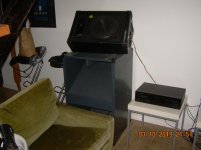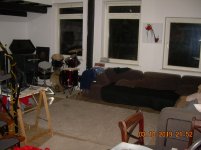Alright, thanks again for your inputs, that gives me some good cake to eat  .
.
Just to come back to the amp / crossover question :
A - Would you advice Icepower amps for, let's say, powering :
- 2 x 600W / 8ohms subs drivers
- 1 x 400W / 8ohms midrange driver
- 2 x 100W /8ohms tops drivers
B - Would there be any problem with a MiniDSP HD devices ? From what I read you don't advice it Turbowatch2, why that ?
Bless
Just to come back to the amp / crossover question :
A - Would you advice Icepower amps for, let's say, powering :
- 2 x 600W / 8ohms subs drivers
- 1 x 400W / 8ohms midrange driver
- 2 x 100W /8ohms tops drivers
B - Would there be any problem with a MiniDSP HD devices ? From what I read you don't advice it Turbowatch2, why that ?
Bless
YW, but you will need at least 2 mids, not 1.
With high power speakers you want at least 2 (2 channel) amps; 1 for the stereo tops (which each contain at least 1 mid and 1 tweeter) and 1 for the subs.
Then you would have to passively cross the mids to the tweeters with a passive crossover and can use something like the minidsp (Thomann 4x4 mini looks better to me) to cross the subwoofers to the tops.
The better solution would be to get at least 3 amps; 1 for tweeters, 1 for mids and 1 for subs. Instead of the mini dsp you now need more output channels. The DBX driverack PA2 is recommended.
You could use 1 or 2 better or less powerful amp for the top speakers and a lesser one for the subwoofers but difference between amps are very small compared to the speakers and their correct setup.
With high power speakers you want at least 2 (2 channel) amps; 1 for the stereo tops (which each contain at least 1 mid and 1 tweeter) and 1 for the subs.
Then you would have to passively cross the mids to the tweeters with a passive crossover and can use something like the minidsp (Thomann 4x4 mini looks better to me) to cross the subwoofers to the tops.
The better solution would be to get at least 3 amps; 1 for tweeters, 1 for mids and 1 for subs. Instead of the mini dsp you now need more output channels. The DBX driverack PA2 is recommended.
You could use 1 or 2 better or less powerful amp for the top speakers and a lesser one for the subwoofers but difference between amps are very small compared to the speakers and their correct setup.
Last edited:
Simple as that, miniDSP is not symmetric (the symmetric version is for car audio), that will give you a whole lot of trouble in a PA.
The miniDSP in all its versions is a very limited, cheap build, dear sold first version of a low cost DSP. It has all kind of minor problems, which most users did accept because of the once low price. a lot of people sent it back after a trial...
The Thomann DSP is a robust (no plastic case) symmetric version with problems solved and 1/3 less expensive. For PA this is better, tougher and cheaper.
Start with one, maybe, and later use one of them per PA side. IMO it is cheaper to go active from the beginning for all speakers than trying to x-over passive, because a good passive one is a. expensive, then b. unflexible and c. not easy to design for a DIYS speaker combination. With a DSP you will find a good x-over set-up for any decent combination of drivers, you just need a cheap microphone.
So full active is the way to go. Even if you are not able to design a passive combination, chances are good you will get a DSP solution working without killing amp or speaker chassis. With two 4-channel DSP you have still an emergency set-up ready (up to 4-way mono) when one side fails. Which shall not happen, but **** happens.
The miniDSP in all its versions is a very limited, cheap build, dear sold first version of a low cost DSP. It has all kind of minor problems, which most users did accept because of the once low price. a lot of people sent it back after a trial...
The Thomann DSP is a robust (no plastic case) symmetric version with problems solved and 1/3 less expensive. For PA this is better, tougher and cheaper.
Start with one, maybe, and later use one of them per PA side. IMO it is cheaper to go active from the beginning for all speakers than trying to x-over passive, because a good passive one is a. expensive, then b. unflexible and c. not easy to design for a DIYS speaker combination. With a DSP you will find a good x-over set-up for any decent combination of drivers, you just need a cheap microphone.
So full active is the way to go. Even if you are not able to design a passive combination, chances are good you will get a DSP solution working without killing amp or speaker chassis. With two 4-channel DSP you have still an emergency set-up ready (up to 4-way mono) when one side fails. Which shall not happen, but **** happens.
Last edited:
I agree that this project is a bit optimistic. 15inch 45 Hz and 500 people outdoors is not a good idea. You will have sound, but it will not be loud. When people also begin to get loud, then you have to play louder, and you will reach the limit fast. It's not even enough for indoor small venue 200 people.
Last edited:
Thanks again for the inputs, that helps me a lot in the hardware choice.
- Think, so you advice 2 subs, 2 mids, 2 tops ? I think I lost you when you wrote about a 2.1 solution. From what I understood you adviced me to go with :
- 2 x 15" subs up to 200hz
- 1 x 8" midrange from 200hz to 800hz/1kHz
- 2 x tops from 1kHz and higher
Or maybe you are telling me that there is the option to choose 2 x 6" midrange instead of 1 x 8" ?
And thanks for the crossover/amp recommendations, I will try to keep it simple for now with 2 amps
- Turbowatch thanks, I'm getting now a clearer vision of these MiniDSP products, at least they have a good marketing team. For going active, yes, that was (and still is) the plan; 100% active for full flexibility and limiters configured in the DSP in order to protect the amps / speakers.
- Kjeldsen yes ! What would you advice as a minimum configuration for 500PAX outdoor ? I don't want to go below 45Hz because the PA would use too much electricity from my small generator (this is also the reason why I started the topic telling that I wanted to built a 2-way system with powerful mid range drivers in order to cover frequencies from 45hz to 800Hz).
- Think, so you advice 2 subs, 2 mids, 2 tops ? I think I lost you when you wrote about a 2.1 solution. From what I understood you adviced me to go with :
- 2 x 15" subs up to 200hz
- 1 x 8" midrange from 200hz to 800hz/1kHz
- 2 x tops from 1kHz and higher
Or maybe you are telling me that there is the option to choose 2 x 6" midrange instead of 1 x 8" ?
And thanks for the crossover/amp recommendations, I will try to keep it simple for now with 2 amps
- Turbowatch thanks, I'm getting now a clearer vision of these MiniDSP products, at least they have a good marketing team. For going active, yes, that was (and still is) the plan; 100% active for full flexibility and limiters configured in the DSP in order to protect the amps / speakers.
- Kjeldsen yes ! What would you advice as a minimum configuration for 500PAX outdoor ? I don't want to go below 45Hz because the PA would use too much electricity from my small generator (this is also the reason why I started the topic telling that I wanted to built a 2-way system with powerful mid range drivers in order to cover frequencies from 45hz to 800Hz).
you need at least 2 (top)speakers; the left and right speakers, both contain a tweeter and mid driver(s) and the passive crossover if you use one.
X Number of sub/basswoofers: depends on how much output you need.
Crossover points will depend on your speaker and soundsystem design.
PA Systems + Power Handling Vs. Efficiency are great articles.
video about line source and line array speakers: YouTube
PA forum is at https://www.diyaudio.com/forums/pa-systems/
X Number of sub/basswoofers: depends on how much output you need.
Crossover points will depend on your speaker and soundsystem design.
PA Systems + Power Handling Vs. Efficiency are great articles.
video about line source and line array speakers: YouTube
PA forum is at https://www.diyaudio.com/forums/pa-systems/
Last edited:
It seems you will benefit from high efficiency.
Try read this
Tuba 18 not just this type, but read the site in general
Benefits. High SPL even with 15 inch. Smaller amplifier requirements, but the size of cabinets will increase.
For a normal PA setup I will say 18inch plus 15inch + 2inch horn. Two stacks for stereo. This is absolute minimum. But try visit some outdoor concerts and talk to the sound engineer
Try read this
Tuba 18 not just this type, but read the site in general
Benefits. High SPL even with 15 inch. Smaller amplifier requirements, but the size of cabinets will increase.
For a normal PA setup I will say 18inch plus 15inch + 2inch horn. Two stacks for stereo. This is absolute minimum. But try visit some outdoor concerts and talk to the sound engineer
Last edited:
Hey again everyone and thanks so much for your inputs and advices. I'm almost set with the hardware choice and the only missing part is the amp
Now, as I would like to include it in the same box of the crossover for space restrictions, I'm still looking into the Icepower or DIY ones ( Professional - ICEpower the world ).
If yes, would this configuration be an good idea ? I'm afraid the amp will be too weak or will heat too much, but in any cases I will almost never push the elements at their full capacity. Again I'am aware that it's advised to choose an amp that is at 1.5x the RMS power of the elements, but I plan to use a limiter on the crossover/DSP in order to protect them :
1 x 1200AS1 (1 channel at 4Ohms)
- one channel for the two Beyma 15P80Nd - 15" Woofer in parralel (4Ohms)
1 x 700AS2 (2 channels at 4Ohms):
- one channel for the 2 midbass Beyma 8MC500Nd - 8" Mid Bass in parallel
- one channel for the 2 tops Beyma CP-855Nd - 1.4" Compression Driver
Also in this case I will be using two ACs (one for the 1200AS1 and one for the 700AS1, would it be a problem ?
chermann already gave a constructive input but I would be happy to get more ideas in order to make a final decision.
THX !
Now, as I would like to include it in the same box of the crossover for space restrictions, I'm still looking into the Icepower or DIY ones ( Professional - ICEpower the world ).
If yes, would this configuration be an good idea ? I'm afraid the amp will be too weak or will heat too much, but in any cases I will almost never push the elements at their full capacity. Again I'am aware that it's advised to choose an amp that is at 1.5x the RMS power of the elements, but I plan to use a limiter on the crossover/DSP in order to protect them :
1 x 1200AS1 (1 channel at 4Ohms)
- one channel for the two Beyma 15P80Nd - 15" Woofer in parralel (4Ohms)
1 x 700AS2 (2 channels at 4Ohms):
- one channel for the 2 midbass Beyma 8MC500Nd - 8" Mid Bass in parallel
- one channel for the 2 tops Beyma CP-855Nd - 1.4" Compression Driver
Also in this case I will be using two ACs (one for the 1200AS1 and one for the 700AS1, would it be a problem ?
chermann already gave a constructive input but I would be happy to get more ideas in order to make a final decision.
THX !
2 x 700AS2 or are you going to run the top speakers (2 boxes which both contain at least 1 mid+ 1 tweeter) in mono like the sub/bass woofers?
I don't get your design as all selected drivers peak around 1kHz???
Did you select all drivers on the not very useful power and efficiency (dB/W) specs?
I don't get your design as all selected drivers peak around 1kHz???
Did you select all drivers on the not very useful power and efficiency (dB/W) specs?
Last edited:
In fact, 2 x 700AS2 ^^ Thanks Think
For the driver selection, my plan is to use the 15" as a subwoofer (only from 45hz) + midbass untill 800Hz. And as you told me that the reality is often different than the calculations on the mediums when going 2 ways, Ive decided to add the 8MC500ND to composate the lack kf mediums. About the 855ND, I choosed them because they start quite early (from 800hz).
Ive also chosed high SPL elements as I really need a good electric/SPL ratio
I believe I will be able to flaten as much as possible the frequency curve thanks to the active crossover/dsp.
I was also thinking going this one Beyma 15MC700 - 15" Subwoofer but doing the calculations in the same box (80L) at 800W, it performs the same and the Xmax of the 15P80ND is not reached.
I also chosed high SPL element as I would like to get the best electric/DB ratio
For the driver selection, my plan is to use the 15" as a subwoofer (only from 45hz) + midbass untill 800Hz. And as you told me that the reality is often different than the calculations on the mediums when going 2 ways, Ive decided to add the 8MC500ND to composate the lack kf mediums. About the 855ND, I choosed them because they start quite early (from 800hz).
Ive also chosed high SPL elements as I really need a good electric/SPL ratio
I believe I will be able to flaten as much as possible the frequency curve thanks to the active crossover/dsp.
I was also thinking going this one Beyma 15MC700 - 15" Subwoofer but doing the calculations in the same box (80L) at 800W, it performs the same and the Xmax of the 15P80ND is not reached.
I also chosed high SPL element as I would like to get the best electric/DB ratio
Last edited:
In order to be sure, I've modelized the curves for the both drivers a their Xmax on HornResp, and here are the results :
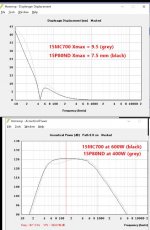
If I understand well and havent done mistakes, for less power used (400W vs 600W), I will loose maximum 3 DB between 50Hz-1.2KHz while keeping a similar SPL between 45Hz-50Hz and from 1.2KHz to 600 right ?

If I understand well and havent done mistakes, for less power used (400W vs 600W), I will loose maximum 3 DB between 50Hz-1.2KHz while keeping a similar SPL between 45Hz-50Hz and from 1.2KHz to 600 right ?
Last edited:
+ some losses due to power compression.
Unfortunately, two 15" subwoofers will not do for DJ work for 500 people. It just is not loud enough. Harman has made a target curve for PA systems. It describes the preference of people and it contains a bass boost and a shallow high frequency roll off. Therefore the demand on the subwoofers is increased.
Unfortunately, two 15" subwoofers will not do for DJ work for 500 people. It just is not loud enough. Harman has made a target curve for PA systems. It describes the preference of people and it contains a bass boost and a shallow high frequency roll off. Therefore the demand on the subwoofers is increased.
Last edited:
this Harman target curve is very interesting TBTL, Danke ^^
From your experience, will there be a significant electric power increase if going from 15" to 18" ? As it's something that I need to keep an eye on.
This is the comparison between the a 15" and 18" on a tapped horn configuration at 400W / 8ohms
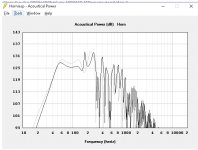
From your experience, will there be a significant electric power increase if going from 15" to 18" ? As it's something that I need to keep an eye on.
This is the comparison between the a 15" and 18" on a tapped horn configuration at 400W / 8ohms

There is still some confusion what open air means.
If you want decent sound, you can not use a 15" or 18" that is intended to do work down at 45 Hz as a mid range up to 800Hz, too.
You should cut them at 200Hz. Then, an additional cone speaker, like the 8" you mentioned, takes over. IMO better a 2x8" or 2x10" with a good horn in between.
Many years ago, if you could place them on top of each other, for limited sound pressure indoor use (discothek), a 15" would run up to 600 Hz followed by a large horn and a tweeter. Still sounds good for HIFI. But this is indoor.
If you push large cones to the limit, what you will do, if you only have limited budget, they can not deliver clear mid range at the same time.
Also, the higher frequency has to go over the heads of the crowd. This means, if you do mid range with the sub, it has to be at least higher than 2 meter.
See, there are some things you can correct with good speakers. Beyma are. But you can not beat physic´s, even with the best material.
If you want decent sound, you can not use a 15" or 18" that is intended to do work down at 45 Hz as a mid range up to 800Hz, too.
You should cut them at 200Hz. Then, an additional cone speaker, like the 8" you mentioned, takes over. IMO better a 2x8" or 2x10" with a good horn in between.
Many years ago, if you could place them on top of each other, for limited sound pressure indoor use (discothek), a 15" would run up to 600 Hz followed by a large horn and a tweeter. Still sounds good for HIFI. But this is indoor.
If you push large cones to the limit, what you will do, if you only have limited budget, they can not deliver clear mid range at the same time.
Also, the higher frequency has to go over the heads of the crowd. This means, if you do mid range with the sub, it has to be at least higher than 2 meter.
See, there are some things you can correct with good speakers. Beyma are. But you can not beat physic´s, even with the best material.
Got it Turbowatch, 2 ways is not an option for sure. I will experiment a lot I believe.
Any advises about the amplifier part ? Im about to try with the Icepower as, in any cases, I will not push the bass drivers more than 500W because of the Xmax / physics as you wrote (tapped horn or vented configuration).
Any advises about the amplifier part ? Im about to try with the Icepower as, in any cases, I will not push the bass drivers more than 500W because of the Xmax / physics as you wrote (tapped horn or vented configuration).
Hi again, why nobody talked to me about Powersoft Audio DigiMod products ? XD
Anyway, my other question is about putting a horn in front of the midrange drivers, I see that a lot are doing it when building midrange horn loaded tops. Is it worst it ? What are the pro / cons ?
First picture without, second picture with
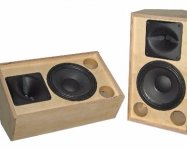
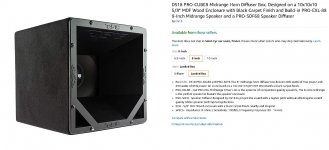
Thanks !
Anyway, my other question is about putting a horn in front of the midrange drivers, I see that a lot are doing it when building midrange horn loaded tops. Is it worst it ? What are the pro / cons ?
First picture without, second picture with


Thanks !
The horn speaker you showed is complete BS. Maybe if you are attracted to carpet...
A decent mid frequency horn looks like this:
Speakerplans.com
The horn throat gives the sound a uniform direction. Without, the lower frequency would radiate around the box, while higher frequency is directed forward. Just physics you can´t change.
OK for short distances (stage monitor), but not to please the crowd in the distance.
The high frequency horn must match the mid frequency´s angle.
Conical horns are a no-no for any sound quality, as they direct sound well, but distort terrible. You know the horn´s that are used in water sport´s? Ever heard a voice through such a cone? That is what the "carpet horn" will sound like.
A decent mid frequency horn looks like this:
Speakerplans.com
The horn throat gives the sound a uniform direction. Without, the lower frequency would radiate around the box, while higher frequency is directed forward. Just physics you can´t change.
OK for short distances (stage monitor), but not to please the crowd in the distance.
The high frequency horn must match the mid frequency´s angle.
Conical horns are a no-no for any sound quality, as they direct sound well, but distort terrible. You know the horn´s that are used in water sport´s? Ever heard a voice through such a cone? That is what the "carpet horn" will sound like.
- Status
- This old topic is closed. If you want to reopen this topic, contact a moderator using the "Report Post" button.
- Home
- Amplifiers
- Class D
- 2 x 800W (8Ohm) on 1200AS2 ICEpower, good idea ?
